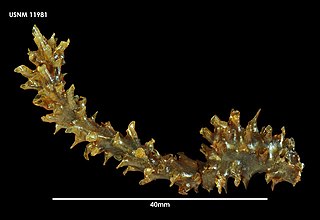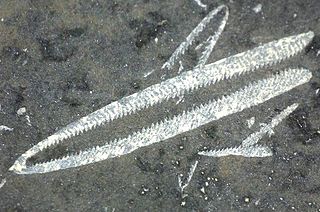
Hemichordata is a phylum which consists of triploblastic, enterocoelomate, and bilaterally symmetrical marine deuterostome animals, generally considered the sister group of the echinoderms. They appear in the Lower or Middle Cambrian and include two main classes: Enteropneusta, and Pterobranchia. A third class, Planctosphaeroidea, is known only from the larva of a single species, Planctosphaera pelagica. The class Graptolithina, formerly considered extinct, is now placed within the pterobranchs, represented by a single living genus Rhabdopleura.

Graptolites are a group of colonial animals, members of the subclass Graptolithina within the class Pterobranchia. These filter-feeding organisms are known chiefly from fossils found from the Middle Cambrian through the Lower Carboniferous (Mississippian). A possible early graptolite, Chaunograptus, is known from the Middle Cambrian. Recent analyses have favored the idea that the living pterobranch Rhabdopleura represents an extant graptolite which diverged from the rest of the group in the Cambrian. Fossil graptolites and Rhabdopleura share a colony structure of interconnected zooids housed in organic tubes (theca) which have a basic structure of stacked half-rings (fuselli). Most extinct graptolites belong to two major orders: the bush-like sessile Dendroidea and the planktonic, free-floating Graptoloidea. These orders most likely evolved from encrusting pterobranchs similar to Rhabdopleura. Due to their widespread abundance, planktonic lifestyle, and well-traced evolutionary trends, graptoloids in particular are useful index fossils for the Ordovician and Silurian periods.

Pterobranchia is a class of small worm-shaped animals. They belong to the Hemichordata, and live in secreted tubes on the ocean floor. Pterobranchia feed by filtering plankton out of the water with the help of cilia attached to tentacles. There are about 25 known living pterobranch species in three genera, which are Rhabdopleura, Cephalodiscus, and Atubaria. On the other hand, there are several hundred extinct genera, some of which date from the Cambrian Period.
Yuknessia is an early pterobranch, known from the Burgess shale, the Chengjiang and the Wheeler shale. Long, unbranched fronds emerge from a central holdfast-like body covered in small conical plates. 23 specimens of Yuknessia are known from the Greater Phyllopod bed, where they comprise < 0.1% of the community. The genus contains two species: the type species Y. simplex and Y. stephenensis. It was originally interpreted as a green alga, and has since been reinterpreted it as a colonial pterobranch.
Dalyia is a pterobranch known from the middle Cambrian Burgess shale. It was previously interpreted as a red alga. It has smooth or faintly lineated stems, which branch into up to four equal branches at branching points. 37 specimens of Dalyia are known from the Greater Phyllopod bed, where they comprise 0.07% of the community.
The Lower-Middle Cambrian animal Rhabdotubus is the earliest known pterobranch. It bears strong similarity to the graptolites - indeed for some time it was misclassified as a dendroid graptolite.

Cephalodiscida is one of two orders in the class Pterobranchia, which are small, worm-shaped animals. Members belong to the hemichordates. Species in this order are sessile, living in clear water and secrete tubes on the ocean floor.

Rhabdopleurida is one of three orders in the class Pterobranchia, which are small, worm-shaped animals, are the only surviving graptolites. Members belong to the hemichordates. Species in this order are sessile, colonial, connected with a stolon, living in clear water and secrete tubes called tubarium. They have a single gonad, the gill slits are absent and the collar has two tentaculated arms. Rhabdopleura is the best studied pterobranch in developmental biology. Rhabdopleura is the only extant graptolite.

Monograptidae is an extinct family of graptolites of the order Graptoloidea. Monograptids have only one row of thecae per stipe, unlike the biserial graptolites which have two opposing rows of thecae per stipe.

Cephalodiscus is a genus of hemichordates in the monotypic family Cephalodiscidae of the order Cephalodiscida.

The Waukesha Biota is an important fossil site located in Waukesha and Franklin, Milwaukee County within the state of Wisconsin. This biota is preserved in certain strata within the Brandon Bridge Formation, which dates to the early Silurian period. It is known for the exceptional preservation of soft-bodied organisms, including many species found nowhere else in rocks of similar age. The site's discovery was announced in 1985, leading to a plethora of discoveries. This biota is one of the few well studied Lagerstättes from the Silurian, making it important in our understanding of the period's biodiversity. Some of the species are not easily classified into known animal groups, showing that much research remains to be done on this site. Other taxa that are normally common in Silurian deposits are rare here, but trilobites are quite common.
Atubaria heterolopha is a species of hemichordates in the monotypic genus Atubaria and in the monotypic family Atubaridae. This taxon belongs to the pterobranchian order Cephalodiscida. It was described by Tadao Sato in 1936 from specimens found feeding on a colony of the hydrozoan Dycoryne conferta in Sagami Bay, Japan.
Rhabdopleura annulata is a sessile hemichordate. It is a suspension feeder that secretes tubes on the ocean floor.

Rhabdopleura compacta is a sessile hemichordate. It is a suspension feeder that secretes tubes on the ocean floor.
Rhabdopleura striata is a sessile hemichordate. It is a suspension feeder that secretes tubes on the ocean floor.
Sigmagraptidae is an extinct family of graptolites.

Dichograptidae is an extinct family of graptolites. Fossils are found mostly from the Late Ordovician to the Early Devonian.
Normalograptidae is an extinct family of graptolites.
Cephalodiscus calciformis is a sessile hemichordate belonging to the order Cephalodiscida. It is the only pterobranch species with funnel-shaped tubaria.

Tontoia is a dubious genus of arthropod known from the Cambrian Burgess Shale, known from a fossil proposed to be the external mould of an arthropod exoskeleton. In its original description by Charles D. Walcott it was initially suggested that Tontoia might be a trilobite, but it is currently considered to be a nomen dubium, and it is unclear whether it even represents an arthropod.










